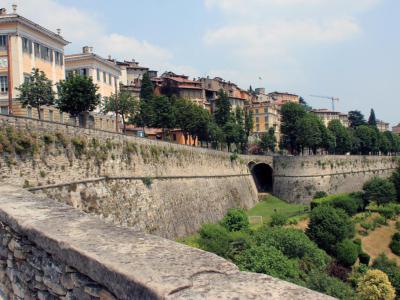Mura Veneziane di Bergamo (Venetian Walls of Bergamo), Bergamo
The Venetian walls of Bergamo are a remarkable architectural marvel dating back to the 16th century. These walls have remained remarkably well-preserved over the centuries, as they were spared from the ravages of war. The construction of the walls included 14 bulwarks, 2 floors, 32 sentry boxes (only one of which has survived), 100 gun openings, two powder magazines, and four gates (Sant'Agostino, San Giacomo, Sant'Alessandro, and San Lorenzo, also known as Garibaldi Gate).
In addition to these features, there were numerous military passages and exits, some of which have been lost to memory. One such example is the Gate of the Lower Pantano, which dates back to the 13th century and served as a connection to Borgo Canale Street. Another, the Gate of the Upper Pantano, provided access to the upper part of the Visconti Citadel but has since disappeared. Externally, the ramparts give the city the appearance of an impregnable fortress. However, since their construction in the late 16th century, the emergence of cannons with parabolic bombardment rendered them obsolete as a defensive structure.
Since July 9, 2017, the Venetian walls of Bergamo have been recognized as a UNESCO World Heritage Site. These walls define the old town, also known as the upper historic center. Originally built to protect the city from the Republic of Milan and France during the decline of Venice's control over maritime trade, the walls now serve as a symbol of Bergamo's rich history.
Walking alongside the walls and through the surrounding parks allows visitors to immerse themselves in the fairytale-like atmosphere of Bergamo's upper town.
In addition to these features, there were numerous military passages and exits, some of which have been lost to memory. One such example is the Gate of the Lower Pantano, which dates back to the 13th century and served as a connection to Borgo Canale Street. Another, the Gate of the Upper Pantano, provided access to the upper part of the Visconti Citadel but has since disappeared. Externally, the ramparts give the city the appearance of an impregnable fortress. However, since their construction in the late 16th century, the emergence of cannons with parabolic bombardment rendered them obsolete as a defensive structure.
Since July 9, 2017, the Venetian walls of Bergamo have been recognized as a UNESCO World Heritage Site. These walls define the old town, also known as the upper historic center. Originally built to protect the city from the Republic of Milan and France during the decline of Venice's control over maritime trade, the walls now serve as a symbol of Bergamo's rich history.
Walking alongside the walls and through the surrounding parks allows visitors to immerse themselves in the fairytale-like atmosphere of Bergamo's upper town.
Want to visit this sight? Check out these Self-Guided Walking Tours in Bergamo. Alternatively, you can download the mobile app "GPSmyCity: Walks in 1K+ Cities" from Apple App Store or Google Play Store. The app turns your mobile device to a personal tour guide and it works offline, so no data plan is needed when traveling abroad.
Mura Veneziane di Bergamo (Venetian Walls of Bergamo) on Map
Sight Name: Mura Veneziane di Bergamo (Venetian Walls of Bergamo)
Sight Location: Bergamo, Italy (See walking tours in Bergamo)
Sight Type: Attraction/Landmark
Guide(s) Containing This Sight:
Sight Location: Bergamo, Italy (See walking tours in Bergamo)
Sight Type: Attraction/Landmark
Guide(s) Containing This Sight:
Walking Tours in Bergamo, Italy
Create Your Own Walk in Bergamo
Creating your own self-guided walk in Bergamo is easy and fun. Choose the city attractions that you want to see and a walk route map will be created just for you. You can even set your hotel as the start point of the walk.
Bergamo Introduction Walking Tour
The first thing you notice about Bergamo is topography. Situated at the foothills of the Italian Alps, in the Lombardy region of northern Italy, Bergamo has been divided into two parts, the Upper Town and the Lower Town (Città Alta and Città Bassa), since the 15th century. The flat Lower Town rises steeply to the Upper Town, perched on a picturesque hill's crest.
Historically, Lower... view more
Tour Duration: 1 Hour(s)
Travel Distance: 0.9 Km or 0.6 Miles
Historically, Lower... view more
Tour Duration: 1 Hour(s)
Travel Distance: 0.9 Km or 0.6 Miles




